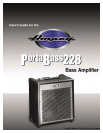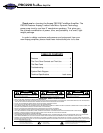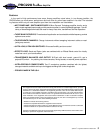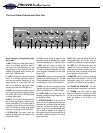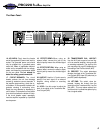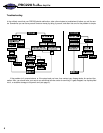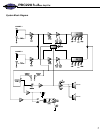
3
PBC228
PortaBass Amplifier
In the world of high performance bass amps, Ampeg amplifiers stand alone. In true Ampeg tradition, the
PBC228 offers you more power, performance and tone than any other bass amplifier in its class. The outstand-
ing features which set your new amplifier apart from the competition are listed below.
• MDT POWER AMP / SWITCH-MODE SUPPLY: Micro Dynamic Technology amplifier circuitry and a
switch-mode regulated power supply provide maximum power in a small lightweight package – the effi-
ciency of these designs eliminates the need for heavy heat sinks, transformers and filter capacitors
• THREE BAND ROTARY EQ: Three bands of equalization and a selectable middle frequency provide
optimum tone control
• TWO SEPARATE CHANNELS: Change instruments without swapping instrument cables or read-
justing amp controls
• ULTRA LOW, ULTRA HIGH SWITCHES: Enhances flexibility and tone control
• EFFECTS LOOP: Send and Return jacks are combined with an Effects Blend control for virtually
noise-free use of your favorite effects
• TRANSFORMER BALANCED LINE OUTPUT: XLR jack with level control, ground lift, and a
pre/post-EQ switch – for patching into house consoles, mixing boards, or external power amplifiers
• ULTRA-PORTABLE COMBO POWER: Two 8” neodymium speakers combined with the lightest,
strongest materials available add up to the biggest-sounding little combo imaginable
• PROUDLY MADE IN THE U.S.A.
Features
Speakon
®
is a registered trademark of Neutrik USA
This equipment has been tested and found to comply with the limits for a Class B digital device, pursuant
to part 15 of the FCC Rules. These limits are designed to provide reasonable protection against harmful
interference in a residential installation. This equipment generates, uses and can radiate radio frequen-
cy energy and, if not installed and used in accordance with the instructions, may cause harmful interfer-
ence to radio communications. However, there is no guarantee that interference will not occur in a par-
ticular installation. If this equipment does cause harmful interference to radio or television reception,
which can be determined by turning the equipment off and on, the user is encouraged to try to correct
the interference by one or more of the following measures:
• Reorient or relocate the receiving antenna.
• Increase the separation between the equipment and the receiver.
• Connect the equipment into an outlet on a circuit different from that to which the receiver is connected.
• Consult the dealer or an experienced radio/TV technician for help.
Changes or modifications to this device not expressly approved by SLM Electronics could void the user’s
authority to operate the equipment under FCC rules.



